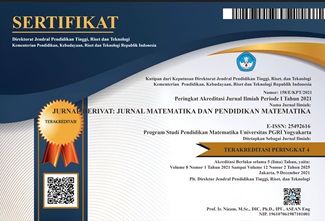Mathematics Model on Syariah Share Pricing in ISSI
DOI:
https://doi.org/10.31316/j.derivat.v7i2.1037Abstract
The ability to read, analyze data, and execute the Syariah economic market agents' decision becomes possible to happen. This research aims to help agents and those how to read the data, analyze, and model the data by providing perspectives regarding the stock pricing in the future. The research method being employed as Autoregressive Integrated Moving Average (ARIMA), which has steps of data plotting transforming, estimating the model, and forecasting. The results of this research found that ARIMA (1,1,0) is the best model of Syariah stock pricing on Indonesian Syariah Stock Indexing (ISSI). The test of model reliability employs RMSE, AIC, BIC/SBC, which is resulted in a fair, competitive suitable test to the employed model.
Keywords: ARIMA, Mathematical Model, Forecasting, Stock
References
Banaezadeh, F., & Haghighat, A. (2015). Evaluation ARIMA Modeling-Based Target Tracking Scheme in Wireless Sensor Networks Using Statistical Tests. Wireless Personal Communications, 84(4), 2913–2925. https://doi.org/10.1007/s11277-015-2772-9
Fard, A. K., & Akbari-Zadeh, M.-R. (2014). A hybrid method based on wavelet, ANN and ARIMA model for short-term load forecasting. Journal of Experimental & Theoretical Artificial Intelligence, 26(2), 167–182. https://doi.org/10.1080/0952813X.2013.813976
Giacomoni, M. H., Kanta, L., & Zechman, E. M. (2013). Complex Adaptive Systems Apporach to Simulate the Sustainability of Water Resources and Urbanization. Journal of Water Resources Planning and Management, 139(June), 554–564. https://doi.org/10.1061/(ASCE)WR.1943-5452
Grigonytė, E. (2016). Short-term wind speed forecasting using ARIMA model. Energetika, 1, 45–55.
Hassan, S., & Othman, Z. (2018). Forecasting on the long term sustainability of the employees provident fund in Malaysia via the Bix- Jenkins ’ ARIMA model. Business and Economic Horizons, 14(1), 43–54. https://doi.org/10.15208/beh.2018.4
Jana, P., & Dwipa, N. M. S. (2017). Pemodelan Dan Forecasting Kebutuhan Air Bersih Di Propinsi Diy Menggunakan Autoregressive Integrated Moving Average Isbn : 978-602-6258-07-6. Prosiding Seminar Nasional Etnomatnesia, 1, 237–242.
LIU, L., LUAN, R. S., YIN, F., ZHU, X. P., & LÜ, Q. (2016). Predicting the incidence of hand, foot and mouth disease in Sichuan province, China using the ARIMA model. Epidemiology and Infection, 144(01), 144–151. https://doi.org/10.1017/S0950268815001144
Nyaboke, C., Orwa, G. O., & Joseph, M. (2017). Time series modelling with application to K enya ’ s inflation data comparison of ARIMA and ARCH models. International Journal of Statistics and Applied Mathematics 2017;, 2(6), 16–22.
Peng, Y., Lei, M., & Peng, J. L. X. (2014). A novel hybridization of echo state networks and multiplicative seasonal ARIMA model for mobile communication traffic series forecasting. Neural Comput & Applic (2014), 24, 883–890. https://doi.org/10.1007/s00521-012-1291-9
Qin, P., & Cheng, C. (2017). Prediction of Seawall Settlement Based on a Combined LS-ARIMA Model. Mathematical Problems in Engineering, 2017. https://doi.org/10.1155/2017/7840569
Rosadi, D. (2011). Analisis Ekonometrika & Runtun Waktu Terapan dengan R (N. W. Kurniawan (ed.); I). Andi Offset.
Sánchez, A. B., Ordóñez, C., Lasheras, F. S., De Cos Juez, F. J., & Roca-Pardiñas, J. (2013). Forecasting SO2 pollution incidents by means of Elman artificial neural networks and ARIMA models. Abstract and Applied Analysis, 2013. https://doi.org/10.1155/2013/238259
Tian, M., Wang, P., & Khan, J. (2016). Drought forecasting with vegetation temperature condition index using arima models in the guanzhong plain. Remote Sensing, 8(9), 1–19. https://doi.org/10.3390/rs8090690
Wang, W. chuan, Chau, K. wing, Xu, D. mei, & Chen, X. Y. (2015). Improving Forecasting Accuracy of Annual Runoff Time Series Using ARIMA Based on EEMD Decomposition. Water Resources Management, 29(8), 2655–2675. https://doi.org/10.1007/s11269-015-0962-6
Yu, Y., Huang, Q., Ma, X., & He, J. (2015). Prediction of Urban Waste Disposal Based on ARIMA Model. Applied Mechanics and Materials, 768(2015), 707–713. https://doi.org/10.4028/www.scientific.net/AMM.768.707
Downloads
Published
Issue
Section
Citation Check
License
Authors who publish with this journal agree to the following terms:
-
Authors retain copyright and grant the journal right of first publication with the work simultaneously licensed under a Creative Commons Attribution-ShareAlike 4.0 International License that allows others to share the work with an acknowledgment of the work's authorship and initial publication in this journal.
- Authors are able to enter into separate, additional contractual arrangements for the non-exclusive distribution of the journal's published version of the work (e.g., post it to an institutional repository or publish it in a book), with an acknowledgment of its initial publication in this journal.
- Authors are permitted and encouraged to post their work online (e.g., in institutional repositories or on their website) prior to and during the submission process, as it can lead to productive exchanges, as well as earlier and greater citation of published work (See The Effect of Open Access).







